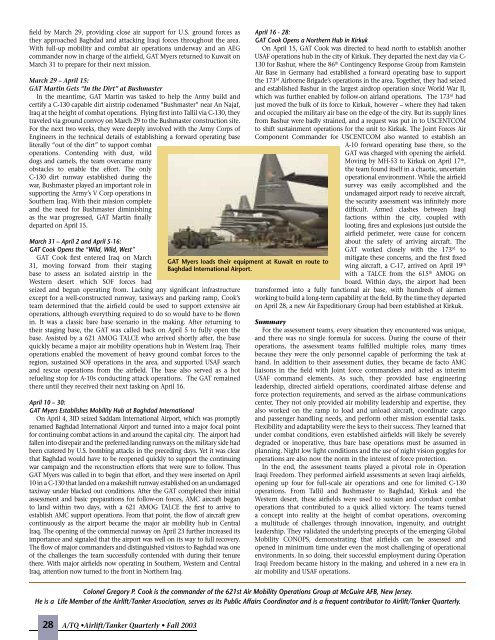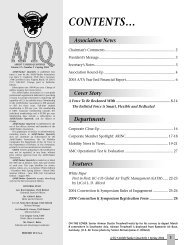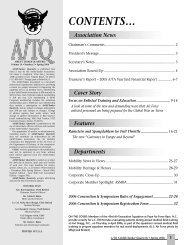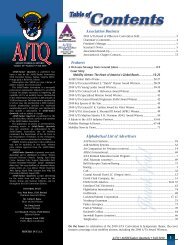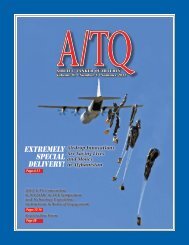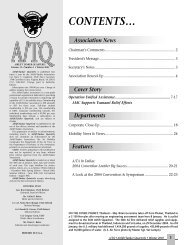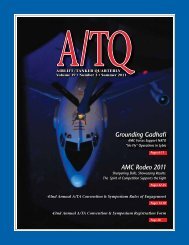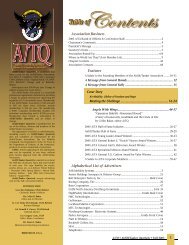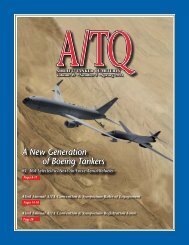1) ATQ Fall 2003 for pdf - Airlift/Tanker Association
1) ATQ Fall 2003 for pdf - Airlift/Tanker Association
1) ATQ Fall 2003 for pdf - Airlift/Tanker Association
You also want an ePaper? Increase the reach of your titles
YUMPU automatically turns print PDFs into web optimized ePapers that Google loves.
field by March 29, providing close air support <strong>for</strong> U.S. ground <strong>for</strong>ces as<br />
they approached Baghdad and attacking Iraqi <strong>for</strong>ces throughout the area.<br />
With full-up mobility and combat air operations underway and an AEG<br />
commander now in charge of the airfield, GAT Myers returned to Kuwait on<br />
March 31 to prepare <strong>for</strong> their next mission.<br />
March 29 – April 15:<br />
GAT Martin Gets “In the Dirt” at Bushmaster<br />
In the meantime, GAT Martin was tasked to help the Army build and<br />
certify a C-130 capable dirt airstrip codenamed “Bushmaster” near An Najaf,<br />
Iraq at the height of combat operations. Flying first into Tallil via C-130, they<br />
traveled via ground convoy on March 29 to the Bushmaster construction site.<br />
For the next two weeks, they were deeply involved with the Army Corps of<br />
Engineers in the technical details of establishing a <strong>for</strong>ward operating base<br />
literally “out of the dirt” to support combat<br />
operations. Contending with dust, wild<br />
dogs and camels, the team overcame many<br />
obstacles to enable the ef<strong>for</strong>t. The only<br />
C-130 dirt runway established during the<br />
war, Bushmaster played an important role in<br />
supporting the Army’s V Corp operations in<br />
Southern Iraq. With their mission complete<br />
and the need <strong>for</strong> Bushmaster diminishing<br />
as the war progressed, GAT Martin finally<br />
departed on April 15.<br />
March 31 – April 2 and April 5-16:<br />
GAT Cook Opens the “Wild, Wild, West”<br />
GAT Cook first entered Iraq on March<br />
31, moving <strong>for</strong>ward from their staging<br />
base to assess an isolated airstrip in the<br />
Western desert which SOF <strong>for</strong>ces had<br />
seized and begun operating from. Lacking any significant infrastructure<br />
except <strong>for</strong> a well-constructed runway, taxiways and parking ramp, Cook’s<br />
team determined that the airfield could be used to support extensive air<br />
operations, although everything required to do so would have to be flown<br />
in. It was a classic bare base scenario in the making. After returning to<br />
their staging base, the GAT was called back on April 5 to fully open the<br />
base. Assisted by a 621 AMOG TALCE who arrived shortly after, the base<br />
quickly became a major air mobility operations hub in Western Iraq. Their<br />
operations enabled the movement of heavy ground combat <strong>for</strong>ces to the<br />
region, sustained SOF operations in the area, and supported USAF search<br />
and rescue operations from the airfield. The base also served as a hot<br />
refueling stop <strong>for</strong> A-10s conducting attack operations. The GAT remained<br />
there until they received their next tasking on April 16.<br />
April 10 – 30:<br />
GAT Myers Establishes Mobility Hub at Baghdad International<br />
On April 4, 3ID seized Saddam International Airport, which was promptly<br />
renamed Baghdad International Airport and turned into a major focal point<br />
<strong>for</strong> continuing combat actions in and around the capital city. The airport had<br />
fallen into disrepair and the preferred landing runways on the military side had<br />
been cratered by U.S. bombing attacks in the preceding days. Yet it was clear<br />
that Baghdad would have to be reopened quickly to support the continuing<br />
war campaign and the reconstruction ef<strong>for</strong>ts that were sure to follow. Thus<br />
GAT Myers was called in to begin that ef<strong>for</strong>t, and they were inserted on April<br />
10 in a C-130 that landed on a makeshift runway established on an undamaged<br />
taxiway under blacked out conditions. After the GAT completed their initial<br />
assessment and basic preparations <strong>for</strong> follow-on <strong>for</strong>ces, AMC aircraft began<br />
to land within two days, with a 621 AMOG TALCE the first to arrive to<br />
establish AMC support operations. From that point, the flow of aircraft grew<br />
continuously as the airport became the major air mobility hub in Central<br />
Iraq. The opening of the commercial runway on April 23 further increased its<br />
importance and signaled that the airport was well on its way to full recovery.<br />
The flow of major commanders and distinguished visitors to Baghdad was one<br />
of the challenges the team successfully contended with during their tenure<br />
there. With major airfields now operating in Southern, Western and Central<br />
Iraq, attention now turned to the front in Northern Iraq.<br />
GAT Myers loads their equipment at Kuwait en route to<br />
Baghdad International Airport.<br />
April 16 - 28:<br />
GAT Cook Opens a Northern Hub in Kirkuk<br />
On April 15, GAT Cook was directed to head north to establish another<br />
USAF operations hub in the city of Kirkuk. They departed the next day via C-<br />
130 <strong>for</strong> Bashur, where the 86 th Contingency Response Group from Ramstein<br />
Air Base in Germany had established a <strong>for</strong>ward operating base to support<br />
the 173 rd Airborne Brigade’s operations in the area. Together, they had seized<br />
and established Bashur in the largest airdrop operation since World War II,<br />
which was further enabled by follow-on airland operations. The 173 rd had<br />
just moved the bulk of its <strong>for</strong>ce to Kirkuk, however – where they had taken<br />
and occupied the military air base on the edge of the city. But its supply lines<br />
from Bashur were badly strained, and a request was put in to USCENTCOM<br />
to shift sustainment operations <strong>for</strong> the unit to Kirkuk. The Joint Forces Air<br />
Component Commander <strong>for</strong> USCENTCOM also wanted to establish an<br />
A-10 <strong>for</strong>ward operating base there, so the<br />
GAT was charged with opening the airfield.<br />
Moving by MH-53 to Kirkuk on April 17 th ,<br />
the team found itself in a chaotic, uncertain<br />
operational environment. While the airfield<br />
survey was easily accomplished and the<br />
undamaged airport ready to receive aircraft,<br />
the security assessment was infinitely more<br />
difficult. Armed clashes between Iraqi<br />
factions within the city, coupled with<br />
looting, fires and explosions just outside the<br />
airfield perimeter, were cause <strong>for</strong> concern<br />
about the safety of arriving aircraft. The<br />
GAT worked closely with the 173 rd to<br />
mitigate these concerns, and the first fixed<br />
wing aircraft, a C-17, arrived on April 19 th<br />
with a TALCE from the 615 th AMOG on<br />
board. Within days, the airport had been<br />
trans<strong>for</strong>med into a fully functional air base, with hundreds of airmen<br />
working to build a long-term capability at the field. By the time they departed<br />
on April 28, a new Air Expeditionary Group had been established at Kirkuk.<br />
Summary<br />
For the assessment teams, every situation they encountered was unique,<br />
and there was no single <strong>for</strong>mula <strong>for</strong> success. During the course of their<br />
operations, the assessment teams fulfilled multiple roles, many times<br />
because they were the only personnel capable of per<strong>for</strong>ming the task at<br />
hand. In addition to their assessment duties, they became de facto AMC<br />
liaisons in the field with Joint <strong>for</strong>ce commanders and acted as interim<br />
USAF command elements. As such, they provided base engineering<br />
leadership, directed airfield operations, coordinated airbase defense and<br />
<strong>for</strong>ce protection requirements, and served as the airbase communications<br />
center. They not only provided air mobility leadership and expertise, they<br />
also worked on the ramp to load and unload aircraft, coordinate cargo<br />
and passenger handling needs, and per<strong>for</strong>m other mission essential tasks.<br />
Flexibility and adaptability were the keys to their success. They learned that<br />
under combat conditions, even established airfields will likely be severely<br />
degraded or inoperative, thus bare base operations must be assumed in<br />
planning. Night low light conditions and the use of night vision goggles <strong>for</strong><br />
operations are also now the norm in the interest of <strong>for</strong>ce protection.<br />
In the end, the assessment teams played a pivotal role in Operation<br />
Iraqi Freedom. They per<strong>for</strong>med airfield assessments at seven Iraqi airfields,<br />
opening up four <strong>for</strong> full-scale air operations and one <strong>for</strong> limited C-130<br />
operations. From Tallil and Bushmaster to Baghdad, Kirkuk and the<br />
Western desert, these airfields were used to sustain and conduct combat<br />
operations that contributed to a quick allied victory. The teams turned<br />
a concept into reality at the height of combat operations, overcoming<br />
a multitude of challenges through innovation, ingenuity, and outright<br />
leadership. They validated the underlying precepts of the emerging Global<br />
Mobility CONOPS, demonstrating that airfields can be assessed and<br />
opened in minimum time under even the most challenging of operational<br />
environments. In so doing, their successful employment during Operation<br />
Iraqi Freedom became history in the making, and ushered in a new era in<br />
air mobility and USAF operations.<br />
Colonel Gregory P. Cook is the commander of the 621st Air Mobility Operations Group at McGuire AFB, New Jersey.<br />
He is a Life Member of the <strong>Airlift</strong>/<strong>Tanker</strong> <strong>Association</strong>, serves as its Public Affairs Coordinator and is a frequent contributor to <strong>Airlift</strong>/<strong>Tanker</strong> Quarterly.<br />
28 A/TQ •<strong>Airlift</strong>/<strong>Tanker</strong> Quarterly • <strong>Fall</strong> <strong>2003</strong>


